Stelco's Railway
Steel Company of Canada
Yard Services Transportation Department
By Ray Hoadley
All photographs Bay City Railway
Historical Foundation unless otherwise credited.
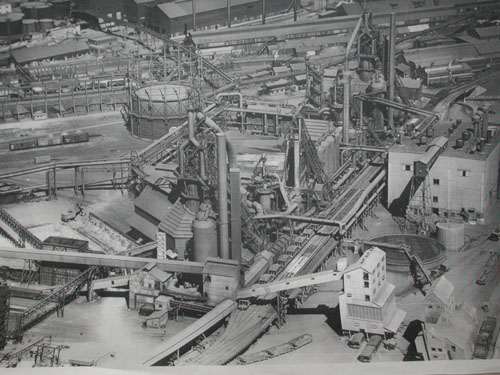
Stelco "D" Blast Furnace and Domestic Coke Screener
in the foreground. 1953. (click to enlarge)
In 1893, permission was granted by the municipal council of the City of
Hamilton Ontario to construction a blast furnace at Huckleberry Point
on Hamilton Harbour. The Hamilton Blast Furnace Company completed construction
in 1895 and began producing pig iron in the tiny blast furnace that summer.
The fledgling mill changed names to the Hamilton Steel and Iron Company,
reorganized as the Hamilton Iron & Steel Company before it joined
forces with several other small mills across Canada in 1910; The Canada
Screw Company, Canada Nut & Bolt Company, The Montreal Rolling Mills
Company and The Dominion Wire Manufacturing Company to become the largest
steel company in Canada, The Steel Company of Canada, more commonly known
as STELCO and June 30, 1980 re-named Stelco Inc.
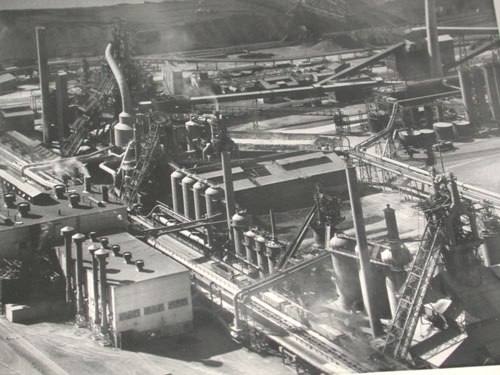
#4 Dock (left to right) Blast Furnaces D, B, A and C.
1953 (click to enlarge)
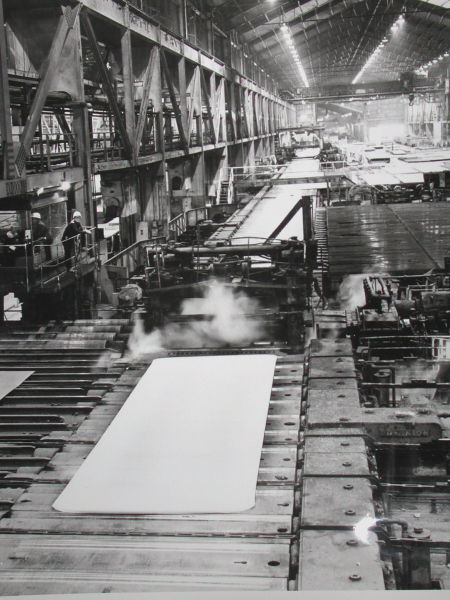
Plate mill
Locomotive Fleet
Locomotive
Gallery
The movement of pig iron and associated materials demanded that the infant
company set up an industrial intra-plant railway system. The first six
locomotives were simple 0-4-0T steam locomotives purchased from defunct
logging companies. As the workload increased over the years the locomotives
became increasingly larger, advancing eventually to 0-6-0 tender type
switch locomotives, many purchased from the Toronto Hamilton & Buffalo
Railway. The first brakemen hired by the new company were drifters (a.k.a.
boomers) off the railroads. Some only worked in the yard seasonally to
avoid the frigid weather on the road.
By 1948, there were 15 locomotives in yard service including steam and
the first diesels. These were 80 ton center cab General Electric switchers
assigned to roustabout duties because of their good tractive effort and
low upkeep. Soon this type of locomotive proved too light for the heavy
trains that were being marshalled and were eventually assigned to lighter
work, shunting scrap and ingot buggies.
The demand for heavier locomotives resulted in the purchase of a 1200
horsepower SW9 in 1951. During the next sixteen years, the Diesel Division
of General Motors built seven SW8 and sixteen SW900 locomotives. These
diesels solved the traction problem quickly and soon the little saddle
tank steamers found their way to the scrap lines. By the end of 1967 the
company had a total of 29 diesels in yard service.
Of special interest was Stelco #40, previously TH&B #40. It arrived
in operating condition in September 1959 and was retained for ten years.
Initially used as a plant switcher, it was soon displaced by the new diesel
fleet. However, #40 escaped the scrappers' torch, when it was used as
a portable boiler during the rebuilding at the Plate Mill and later the
12-10 Mill. Roundhouse foreman, Gord Douglas, supervised a complete overhaul
of the locomotive before it was donated to the National Museum of Science
& Technology in Ottawa in June 1969. It operated there on museum property
providing short train rides until it was once again retired. Stelco #40,
ex TH&B #40, nee TH&B #42 now resides in Lindsay Ontario.
Rail Operations
Left photo: Old eastside yard for inbound and outbound road cars. There
was a newer eastside yard built after this photograph. Right: Westside
yard for inbound and outbound road cars. Note: The old black building
is the Spike Mill where rail spikes were made. Both photos, circa 1948.
Canadian Science and Technology Museum/CN Collection
The Steel Company of Canada operated eleven different facilities in Hamilton,
all requiring rail service. They included Hilton Works, Reinforcing, Parkdale
Works, #2 Rod Mill, Frost Works, Laidlaw Storage, Canada Works East &
West, Ontario Works, West End Storage and Canadian Drawn Works.
By far the largest operation, at six million annual ingot tons in 1972,
was the 1110 acre Hilton Works. Operating as an integrated steel mill,
which could produce new steel from raw materials required a vast quantity
of iron ore, dolomite, limestone and scrap steel. Much of this was delivered
in railway cars, although iron ore and coal also arrived by lake freighter.
The Stelco Railroad, operated by the Yard Services Transportation Department,
employed 600 people in operating and non-operating jobs. Five track gangs
maintained the 72 miles of track, including over 700 switches and repaired
the high priority derailment damage. The Diesel Shop could conduct daily
maintenance on up to four locomotives at a time or do a complete overhaul
on any locomotive in the fleet.
Co-ordination of rail movements was the responsibility of a shift yardmaster,
who was in contact with the TH&B and CNR yardmasters, and four assistant
shift yardmasters. The twenty-seven, four man crews operated around the
clock, seven days a week. Many were employed to move the 1500 pieces of
steel mill rolling stock throughout the plant, most of it not equipped
with air or mechanical brakes, relying strictly on the skill of the engineer
to control the speed of the train. Trainline reservoir air was bled from
inbound railroad cars before they were weighed at #3 or #5 track scales.
Feeding a Hungry Steelmaking Facility
Producing new steel at an integrated steel mill required millions of
tons of scrap steel, which was mixed with the molten iron from the blast
furnaces. During the 1950's, Stelco purchased scrap from as many sources
as it could. Aging lake freighters were tied up for the last time at #1
Ore Dock. The boat salvage crew slowly winched the hulls out of the water
as they torch cut the superstructure into pieces small enough to charge
into the open hearth.

Click to enlarge
The rolling stock was purchased second hand, often as scrap from the mainline
railroads. Once inside the plant, the Car Repair Shop removed the brake
equipment, renumbered it and it remained in service for many more years
before it was scrapped. New rolling stock such as ore jennies, three bay
hoppers, gondolas and billet flat cars began replacing the aging fleet
during the 1970s. In fact, the Car Repair began fabricating heavy duty
gondolas based on the weaknesses of the original cars.
Steam locomotives also provided dense steel scrap from their cast frames
and running gear. Workhorses of the New York Central,
Chesapeake & Ohio as well as local Canadian
locomotives did not escape the scrapper's torch. Most of TH&B's steam
locomotive fleet was purchased by Stelco, however not all of them were
immediately scrapped. Many of the switchers were re-lettered and remained
in active service at Stelco for several years.
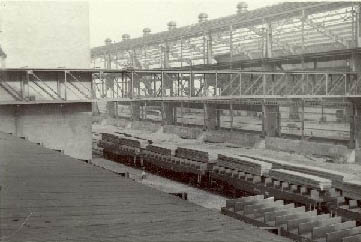
Number 2 Bloom Mill with three Hi-Riser cars; in the background
is building of #2 Conditioning Dept.
Over one hundred and twenty-five tender frames equipped with six wheel
Commonwealth or Buckeye trucks were saved for moving red hot steel slabs
within the plant. These cars were ideal for this type of service. Their
cast steel and rivet construction could withstand the high temperatures
of 150 tons of steel, when a welded construction car would have soon collapsed.
They were refitted at the Car Repair with a coupler at each end and heavy
steel plate risers to raise the hot slabs above the floor of the car,
which was covered with six inches of slag to dissipate the heat. Many
of these cars remained in service until 2001, nearly fifty years later.
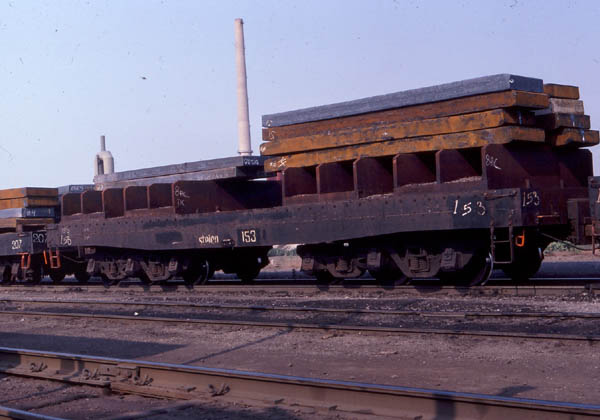
These near-indestructable Hi-Riser cars were rebuilt in
the 1960's from steam locomotive tenders. Ray Hoadley
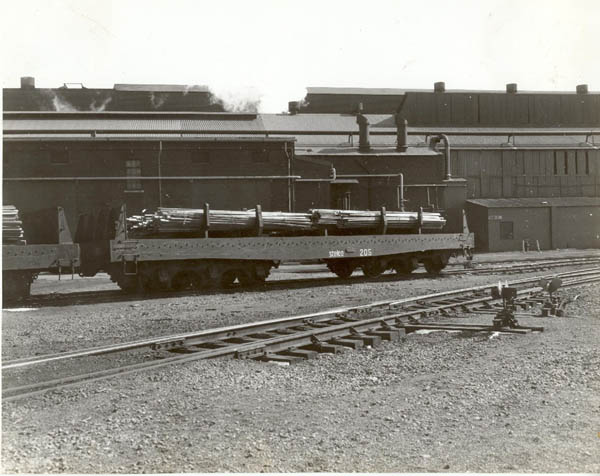
Reindeer car 205, (one of about 8 such cars rebuilt c.1960's
from Hi-Riser cars to carry hot billets),
shown at the 10-9 Mill's billet yard.
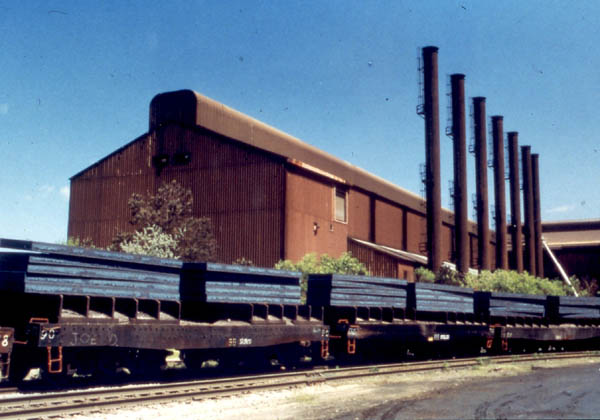
Several "Hi-Riser" cars for the #2 Conditioning
Department. Ray Hoadley
Switching Hilton Works - Circa 1972
In 1972, at the height of operations, the railroad switched five blast
furnaces, seven coke batteries, two steelmaking open hearths with eleven
furnaces, a Basic Oxygen Furnace with three vessels, two ingot stripper
buildings, a Universal Slab Mill, 148" Plate Mill, 56" Hot Strip
Mill, two bloom & billet mills and numerous billet and flat-rolled
finishing mills.
The following describes the typical daily interchange with the Toronto
Hamilton & Buffalo Railway.
0100-0200 TH&B geeps placed iron ore pellets loaded in TH&B or
CP 3 bay offset hoppers from the Hilton iron ore mine as well as cars
of Buffalo coke loaded in NYC hoppers to track 35 in the Ore Yard near
Industrial Drive. The light geeps then pulled the outbound cars from track
31. This usually contained the empty hoppers from the blast furnaces and
any miscellaneous cars from the ironmaking area of the plant such as shipments
of pea, nut or egg coke from the Domestic Screener and empty coke hoppers
from the blast furnace. These cars were pulled to nearby Fisher Yard.
0200-0300 The geeps then returned with the miscellaneous inbound cars
for the east side of the plant and placed them to track 565. This could
include PRR or NYC box cars of fire brick for a variety of blast furnaces,
open hearth furnaces or reheat furnaces in the mills. Zinc ingots, loaded
in Norfolk & Western box cars would be unloaded in the galvanize lines.
Manganese, a steelmaking additive arrived in TH&B 40' box cars with
8' doors. These cars were characterized by the dents in the roof caused
by the manganese being deflected off the roof during loading. TH&B
48' gondolas in the 2200 series shuttled between the local scrap dealers
and the open hearths. Finally, empty rolling stock was placed for steel
shipments. These included CP 65' narrow gondolas to load 60' lengths of
reinforcing rod and 52' gondolas for angle stock, bars, billets and fence
post. TH&B or CP 70 and 100 ton flat cars were placed for plate shipments.
The crew then pulled track 567, the billet shipments for #2 Rod Mill.
These were generally TH&B 2300 series "con-cast" cars equipped
with steel racks and loose stone floors. They were loaded with hot billets
from #16 open hearth caster, #3 Bloom & Billet Mill or #3 Conditioning.
1400-1500 Using a TH&B switcher, the crew placed the con-cast gondola
empties to track 565 after making the reverse at #2 Rod Mill about noon.
The locomotive then pulled the outbound cars from track 563. This could
include plate in either gondolas or loaded on flat cars for Welland Tube
or any other customer. Tin or galvanize coated steel coils were shipped
in regular box cars in warmer weather or heated box cars in the winter
to prevent oxidization. The balance could include empty brick box cars,
empty scrap gondolas or rod and bar shipments.
1900-2000 Again using a switcher, the TH&B placed miscellaneous cars
to track 565 or track 35 in the Ore Yard. The light engine would then
pull the con-cast loads for #2 Rod Mill from track 567.
If additional Hilton ore or more empty gondolas or flat cars were required
to meet production needs, the railway would be asked at any time to make
a special delivery. It was not uncommon for the TH&B to move over
a hundred cars a day for Hilton Works. During this same twenty-four hour
period, Canadian National also provided similar service.
Today
Stelco Hilton Works, recently renamed Stelco Hamilton, still remains
one of the largest integrated steel mills in Canada, producing 2.5 million
tons of steel. Many of the production facilities, which relied on rail
transportation have been demolished in favour of new steelmaking technology
so the railway no longer plays as important a role. Rubber tire equipment
such as multi-wheel 200 ton capacity Paling Transporters move billets,
coils and scrap, while Kress carriers transport hot slabs and blooms from
the caster to the hot strip mill and bloom mill.
The railroad has been reduced to less than twenty-five employees operating
three roustabout locomotives while two other locomotives are dedicated
to the remaining blast furnace to switch hot metal cars out of from under
the casthouse floor. The fleet has been reduced to nine locomotives. The
other twenty diesels have been transferred to another Stelco facility,
sold or cut up for scrap.
A collection of Stelco artefacts, which had never been on public display
were donated to the Bay City Railway Historical Foundation in 1999. They
are now exhibited at the H.O. Model Engineers Society Inc. in Stoney Creek.
Simplified Stelco Hilton Works Railroad Roster
5 American Derricks - 80 ton capacity
6 0-4-0 T
1 0-4-0
2 0-6-0T
15 0-6-0
4 Electrics converted to gas electrics
5 GE 80 ton center cabs
1 GMDD SW9
7 GMDD SW8
16 GMDD SW900
|
